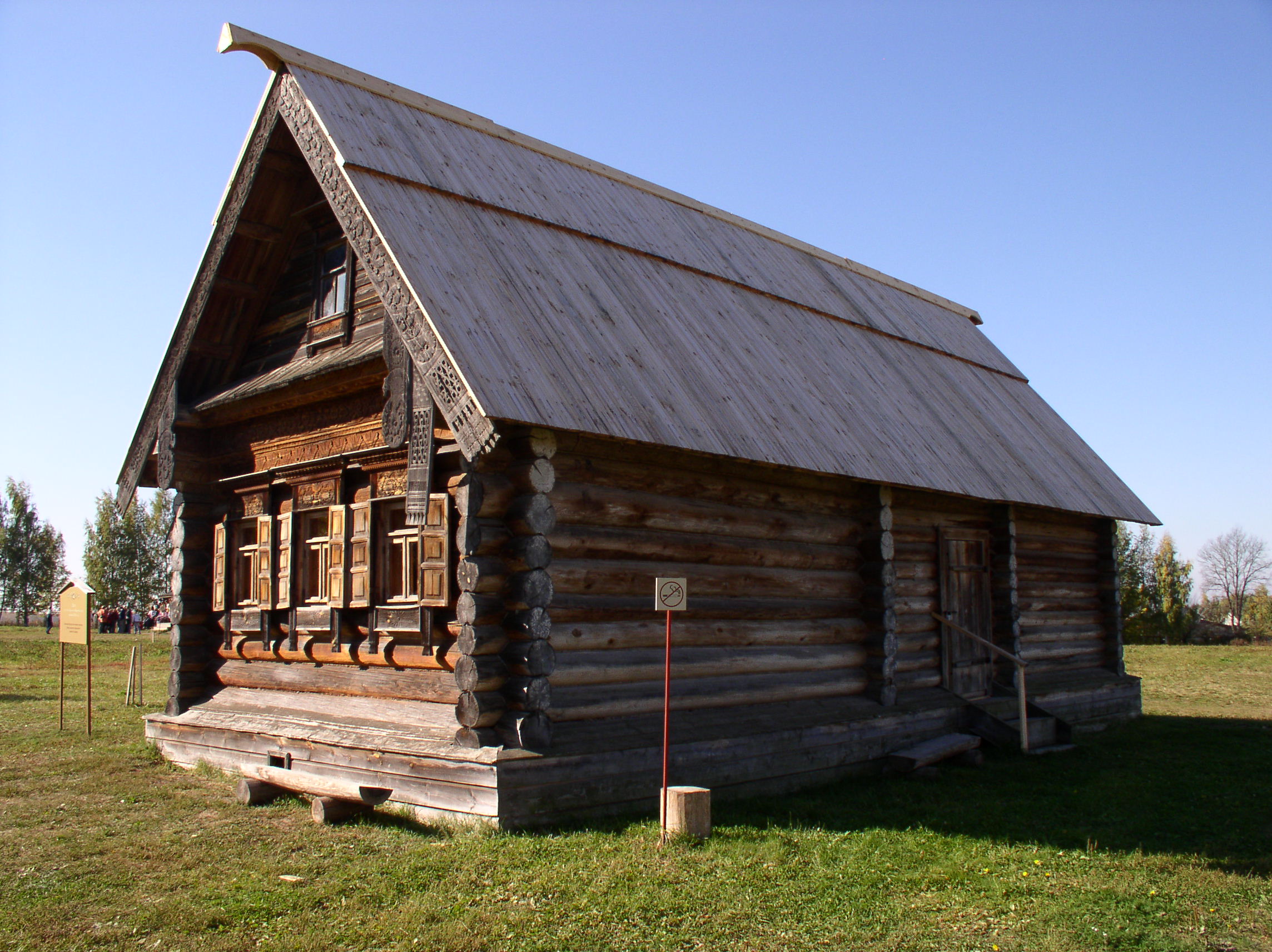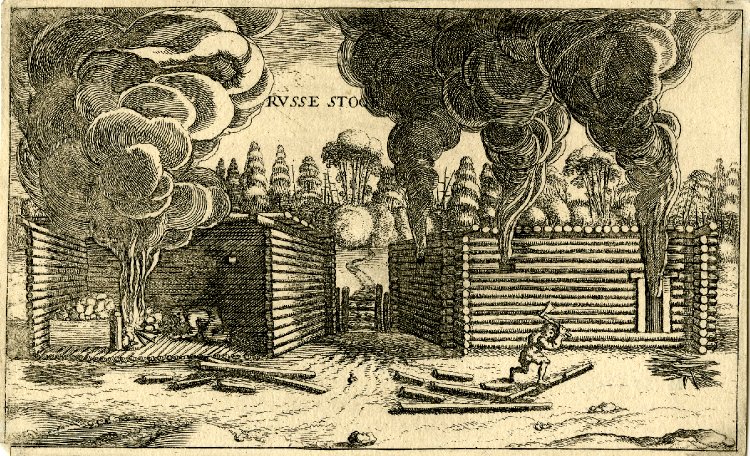Izba on:
[Wikipedia]
[Google]
[Amazon]


 An izba ( rus, изба́, p=ɪzˈba, a=Ru-изба.ogg) is a traditional Russian countryside dwelling. Often a
An izba ( rus, изба́, p=ɪzˈba, a=Ru-изба.ogg) is a traditional Russian countryside dwelling. Often a
Russian izba's Full HD photos
{{Russian souvenirs Houses in Russia House types Log buildings and structures


log house
A log house, or log building, is a structure built with horizontal logs interlocked at the corners by notching. Logs may be round, squared or hewn to other shapes, either handcrafted or milled. The term "log cabin" generally refers to a smal ...
, it forms the living quarters of a conventional Russian farmstead
A farmstead refers to the buildings and service areas associated with a farm. It consists of a house belonging to a farm along with the surrounding buildings. The characteristics of a specific farmstead reflect the local landscape, which provides ...
. It is generally built close to the road and inside a yard
The yard (symbol: yd) is an English units, English unit of length in both the British imperial units, imperial and US United States customary units, customary systems of measurement equalling 3 foot (unit), feet or 36 inches. Sinc ...
, which also encloses a kitchen garden
The traditional kitchen garden, vegetable garden, also known as a potager (from the French ) or in Scotland a kailyaird, is a space separate from the rest of the residential garden – the ornamental plants and lawn areas. It is used for grow ...
, hay
Hay is grass, legumes, or other herbaceous plants that have been cut and dried to be stored for use as animal fodder, either for large grazing animals raised as livestock, such as cattle, horses, goats, and sheep, or for smaller domesticate ...
shed, and barn
A barn is an agricultural building usually on farms and used for various purposes. In North America, a barn refers to structures that house livestock, including cattle and horses, as well as equipment and fodder, and often grain.Allen G ...
within a simple woven stick fence
A fence is a structure that encloses an area, typically outdoors, and is usually constructed from posts that are connected by boards, wire, rails or net (textile), netting. A fence differs from a wall in not having a solid foundation along its ...
. Traditional, old-style izba construction involved the use of simple tools, such as ropes, axes, knives, and spades. Nails were not generally used, as metal was relatively expensive, and neither were saws a common construction tool. Both interior and exterior are of split pine tree trunks, the gap between is traditionally filled with river clay, not unlike the North American log cabin
A log cabin is a small log house, especially a minimally finished or less architecturally sophisticated structure. Log cabins have an ancient history in Europe, and in America are often associated with first-generation home building by settl ...
.
The dominant building material of Russian vernacular architecture
Vernacular architecture (also folk architecture) is building done outside any academic tradition, and without professional guidance. It is not a particular architectural movement or style but rather a broad category, encompassing a wide range a ...
, and material culture
Material culture is culture manifested by the Artifact (archaeology), physical objects and architecture of a society. The term is primarily used in archaeology and anthropology, but is also of interest to sociology, geography and history. The fie ...
generally, for centuries was wood. Specifically houses were made from locally-cut rough-hewn logs, with little or no stone, metal, or glass. Even churches and urban buildings were primarily wooden until the eighteenth century.Hosking, 7
All of the building's components were simply cut and fitted together using a hand axe. Coins, wool, and frankincense
Frankincense, also known as olibanum (), is an Aroma compound, aromatic resin used in incense and perfumes, obtained from trees of the genus ''Boswellia'' in the family (biology), family Burseraceae. The word is from Old French ('high-quality in ...
were customarily placed beneath the corners of the house as an expression of the superstition that doing this would make the people living there healthy and wealthy.
From the fifteenth century on, the central element of the interior of izba was the Russian stove
The Russian stove () is a type of masonry stove that first appeared in the 15th century or earlier. These stoves combine the functions of a traditional stove, oven, and fireplace into a single unit, and serve a broad range of purposes, including ...
, which could occupy up to one quarter of the floorspace in smaller dwellings. Often there were no beds (in the Western sense) for many members of the household, as people would sleep directly on the plaster top of the oven, or on shelves built directly above the stove.Hosking, 8
The outside of izbas was often embellished by various special architectural features, for example the rich wood carving decoration of windows. Such decorative elements and the use of the Russian stove are still commonly found in many modern Russian countryside houses, even though only the older wooden houses are called izbas today.
An alternative word for "izba" in Russian is "khata" (хата), which is the word in most Slavic languages for any cottage or small house (including Belarusian, Polish, and Ukrainian). According to historian of Russia Geoffrey Hosking
Geoffrey Alan Hosking (born 28 April 1942) is a British historian of Russia and the Soviet Union and formerly Leverhulme Research Professor of Russian History at the School of Slavonic and East European Studies (SSEES) at University College, Lon ...
, starting in the eighteenth century khata was used in to refer to cottages on the tree-poor southern steppes which used logs only for the framing, and then used wattle-and-daub
Wattle and daub is a composite building method in which a woven lattice of wooden strips called " wattle" is "daubed" with a sticky material usually made of some combination of wet soil, clay, sand, and straw. Wattle and daub has been used for ...
as infill covered with a plaster and whitewash exterior. However, generally this wattle-and-daub house is called "mazanka
A mazanka (, ) is a traditional Ukraine, Ukrainian countryside dwelling. A house made of clay, raw brick or brushwood (for the roof), plastered with clay mixed with manure or any other organic substance (adobe technique). The walls were later cov ...
" (мазанка) and khata is not necessarily a mazanka.
See also
*Log building
Log buildings and structures can be categorized as historic and modern. They are placed in opposition to wooden structures built using frameworks, according to Eugene Viollet-le-Duc. A diverse selection of their forms and styles with examples of ...
References
External links
Russian izba's Full HD photos
{{Russian souvenirs Houses in Russia House types Log buildings and structures